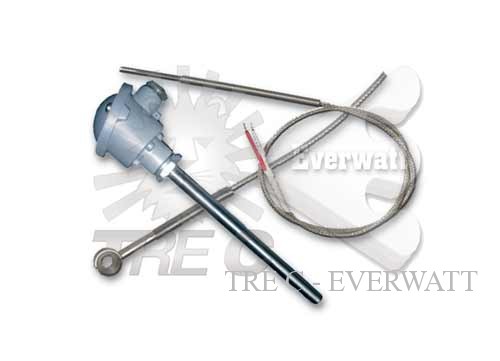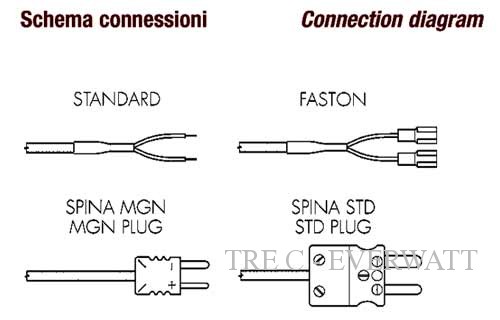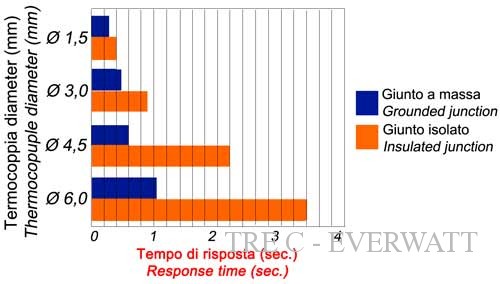
GENERAL CHARACTERISTICS
Thermocouples are temperature sensors that operate by means of two different conductors, joined at their ends. Inside them there is an electrical circuit formed by two metallic conductors of different materials welded together at their ends.
In the presence of a temperature difference between the two junctions, one generates a circulating current, so-called electromotive force, in the event that is open one of the two junctions, which is proportional to the temperature difference, and these joints are called the hot junction (also commonly called “joint degree”), directly exposed to the temperature you want to measure and cold junction (or “reference junction”), corresponding to the junction between the wires of the thermocouple and measuring circuit, while the terminals are at room temperature, the potential difference between them is proportional to the difference between the temperature and the ambient temperature to detect .
The polarization and intensity of the electromotive force generated depends solely on the type of the two metals forming the thermocouple and the temperature at which they subjected the two joints.
For a given temperature, the thermocouple measuring process is necessary that the junction is at a given temperature (usually 0 ° C), so that the current loop generated in (electromotive force) depends solely on the temperature of the hot junction.
Main technical parameters:
Advantages in the use of thermocouples:
| Main types of THERMOCOUPLES |
Temperature Limits
(° C) |
Description
|
|
|
Symbol
|
Materials used
|
||
|
S
|
Pt10%Rh – Pt
|
-50 / 1760°C
|
Advantages:
Disadvantages:
|
|
R
|
Pt13%Rh – Pt
|
-50 / 1760°C
|
See same characteristics as the thermocouple type “S” linked above, but with different percentages of the two noble metals (platinum and rhodium).
|
|
B
|
Pt30%Rh – Pt6%Rh
|
0 / 1820°C
|
Advantages:
|
|
E
|
Cr – Co
|
-270 / 1000°C
|
Advantages:
|
|
J
|
Fe – Co
|
-210 / 1200°C
|
Advantages:
Disadvantages:
|
|
K
|
Cr – Al
|
-270 / 1370°C
|
Advantages:
Disadvantages::
|
|
T
|
Cu – Co
|
-270 / 400″C
|
Advantages:
|
|
N
|
Nicrosil – Nisil
|
-270 / 400°C (*)
0 / 1300°C
(**)
|
Advantages:
(*) Thermocouple wires with a diameter of 0.32 mm
(**) Thermocouple wires with a diameter of 1.63 mm
|
|
W3
|
W3%Re- W25%Re
|
0 / 2310°C
|
Advantages:
Disadvantages:
|
|
W5
|
W5%Re – W26%Re
|
0 / 2310°C
|
Advantages:
|
There are two structural types of thermocouples:
| Thermocouple type | Response Speed | Electrical insulation | Vibration resistance | Resistance to pressure |
| Traditional insulation | Sufficient | Good | Sufficient | Good |
| Mineral insulated (MgO) | Excellent | Excellent | Good | Excellent |
The thermocouples are made with traditional insulation:
Thermocouples with traditional insulation (composition):
Measuring junction (or hot junction) is the area where the two thermocouple wires are joined together, since its dimensions are small, we can consider the measure with point-type thermocouples. The execution of this joint must be done in a way that no mechanical stress on the two conductors (especially for thermocouples made of noble metals) as these, once in temperature would affect the proper functioning of the thermocouple.
2)Thermocouple wires: they must be properly sized according to the conditions of employment; same probe can be inserted into two or more thermocouples.
3)Ceramic insulators: they serve to keep the thermocouple wires insulated along the length of the probe with each other and the external sheath.
4) Protective sheath: the aim is to protect the thermocouple wires, in fact, being in direct contact with the process, it is essential that the sheath is the most suitable material and has specific dimensions. Normally made of metal, if the process temperature is very high, it can also be made of ceramic material. In particular conditions, it is appropriate that the sheath is coated with an additional protection that takes the name of the thermowell.
5) Connection head: contains the terminal of insulating material, usually ceramic, which allows the electrical connection of the thermocouple, for use in explosive atmospheres, it is also possible to equip these thermocouples with heads of ATEX Explosion-proof connections. In place of the terminal you can install a converter with 4-20mA.
Mineral insulated thermocouples MgO (composition):
These thermocouples that can achieve high performance and extended operational life, due to excellent technology with which they are constructed and their mechanical properties, also encased in very small (0.5 mm in diameter), but also very long. Their protective sheath can have very tight bend radii.
Measuring junction, the two conductors forming the thermocouple are joined in the mineral oxide insulated cable. The hot junction may be insulated, grounded or exposed.
Thermocouple wires: in the MgO insulated cable can be two, four or six wires, so the thermocouple can be simple, double or triple.
Mineral insulated sheath: it is composed of a metal sheath containing the conductors insulated from each other and the sheath itself, and this is by means of pure metal oxides and highly compressed, standard insulation magnesium oxide MgO.
Connection head: contains the terminal of insulating material, usually ceramic, which allows the electrical connection of the thermocouple, use explosion-proof enclosures. for use in explosive atmospheres, it is also possible to equip these thermocouples with heads of ATEX Explosion-proof connections. In place of the terminal you can install a converter with 4-20mA.
Ithe following graph shows the time it takes for a thermocouple isolation
Mineral reach 63.2% of the temperature difference measured in water with a speed of 0.4 m / s


Technical Data
A standard thermocouple type has a cylindrical shape with a sheath of stainless steel AISI 304 and MgO mineral insulated, suitable for measurement and control with generic cable outlet protected by a sheath of stainless steel spring, can be simple or double, while the joint measurement can be insulated, grounded or exposed.
| Operating temperature | Varies according to the model depending on the type of cable |
| Accuracy / measurement accuracy | Class 1 and 2 (EN – DIN), Classe A e B (Ansi)
in accordance with regulations EN 60584-2 classe 2, DIN 43710 classe 2, Ansi Mc.96.1 classe STD
|
| Type of terminals / connection type | Standard, Faston, plug-compensated form MGN, shaped plug compensated Standard, with sleeves or with leads of length 7 mm. |
| Type model (temperature scale) / Type of cable | 0/400°C, -40/+200°C, -50/+240°C, 0/400°C |
| Number of sensitive elements | Simple 1 or 2 sensing elements or Double |
| Sensor type | type “J” (Fe-Co),type “K” (Cr-Al), type “T” (Cu-Co), type “N” (Nicrosil-Nisil) |
| Sheath Diameter (OG) | Ø 0,5 – 1 – 1,5 – 2 – 3 – 4 – 4,5 – 6 – 8 mm or other customer-specific |
| Sheath Material | AISI304, AISI316 (max 600°C), INCONEL 600 (max 1150°C) |
| Sheath Length (LG) | 30, 50, 100, 200, 250, 1000 mm or other customer-specific |
| Extension Length (if present) (LC) | to be specified in dm |
| Measuring junction | Exposed, isolated, or Massa |
| Fixing Hole Diameter (F) (if any) | Suitable for M4, M5, M6 |
Alternatively, thermocouples can also be used in immersion applications, complete with connection head, for conventional insulation, suitable for measurement and control systems of general with low, medium or high pressure. These models are installed using a threaded sleeve welded directly on the (fixed) or by special joints or flange sliding compression. The electrical connection is made within the connection head through a ceramic terminal block. On request they can be alternatively provided with an analog output 4-20 mA.
| Operating temperature | Varies depending on the material of the sheath (400 º for TC type T) |
| Accuracy / measurement accuracy | Class 1 and 2 (EN – DIN), Class A and B (ANSI) according to standards EN 60584-2 class 2, DIN 43710 Class 2, ANSI Class Mc.96.1 Standard or Special |
| Electrical connections | M20x1,5 |
| Type model (temperature scale) / Type of cable | 0/400°C, -40/+200°C, -50/+240°C, 0/400°C |
| Number of sensitive elements | Simple or Double |
| Sensor type | type “J” (Fe-Co), type “K” (Cr-Al), type “T” (Cu-Co), type “N” (Nicrosil-Nisil) |
| Sheath Diameter (OG) | Ø 6 – 8 – 10 – 13 – 17 – 21 mm |
| Sheath Material | AISI304, AISI316 (max 600°C), AISI310 (max 1100°C), AISI446 (max. 1050°C), INCONEL 600 (max 1150°C) |
| Immersion length sheath (LG) | 50, 100, 200 mm or other customer-specific |
| Length extension (LE) | no extension, 50, 100 or 150 mm |
| Measuring junction | Exposed (air holes), grounded or isolated |
| Threaded | G. 1/8″, 1/4″, 3/8″, 1/2″ |
| Degree of protection tested shortcut. | min. IP54, IP65, IP65 certified ATEX Eexd IIC T6 |
PRODUCT QUALITY ‘CERTIFIED
Our range of thermocouples, provided in support of our wide range of products and accessories in the field of heat treatment of fluids, air and gas, is subjected to the most stringent controls dimensional and electrical tests in accordance with regulations of our Company Quality System ISO 9001:2015 certified and in full compliance with the requirements of current standards IEC / EN.
THERMOCOUPLES STANDARD CATALOGUE
We can supply standard size and type thermocouples (thermocouples and thermocouple wire type “K”, “J”, etc. …), most of which are available in stock for immediate delivery, where there is no need for thermoregulation particularly complex, in addition, we can easily fulfill specific customer requirements, limited to the target application, as to specific size requirements and / or custom finish to order and terms of delivery within approximately four weeks from receipt of order.
CABLES FOR THERMOCOUPLES (Thermocouple Cables)
In support, we offer a wide range of cables for transmitting signals and thermocouples.
These cables are made of a specific material and heat insulation as a function of temperature and atmosphere which will be used, of which we quote, followed by some physical characteristics for the various types of insulation:
|
For a correct temperature measurement, it is essential that the transmission of the voltage signal produced by the thermocouple to the measuring instrument is not altered in any way and for this, this link allows the cable have to have very similar characteristics to those of the thermocouple.
There are three types of cables for thermocouples:
Below is shown a table that shows, respectively, by type of extension cords and compensation, the nature of the conductors and the tolerances in accordance with international standards.
| Type Extension and Compensating Cables |
Conductors |
Temperature Range |
Norma Standard |
Error limits |
TemperatureTC |
|
|
1 |
2 |
|||||
|
Cu/CuNi |
0/+200°C |
DIN 43710 |
– |
±3,0 °C |
– |
|
|
Fe/CuNi |
0/+200°C |
– |
±3,0 °C |
– |
||
|
Cu/CuNi |
-25/+100°C |
IEC 584 |
±30 µV (±0,5°C) |
±60 µV (±1,0°C) |
300°C |
|
|
NiCr/CuNi |
-25/+200°C |
±120 µV (±1,5°C) |
±200 µV (±1,5°C) |
500°C |
||
|
Fe/CuNi |
-25/+200°C |
±85 µV (±1,5°C) |
±85 µV (±1,5°C) |
500°C |
||
|
NiCr/NiAl |
-25/+200°C |
±60 µV (±1,5°C) |
±100 µV (±1,5°C) |
900°C |
||
|
Fe/CuNi |
0/+150°C |
– |
±100 µV (±2,5°C) |
900°C |
||
|
Cu/CuNi |
0/+100°C |
– |
±100 µV(±2,5°C) |
900°C |
||
|
Cu/CuNi |
0/+100°C |
– |
±30 µV (±2,5°C) |
1000°C |
||
|
Cu/CuNi |
0/+200°C |
– |
±60 µV (±5,0°C) |
1000°C |
||
|
Cu/CuNi |
0/+100°C |
– |
±30 µV (±2,5°C) |
1000°C |
||
|
Cu/CuNi |
0/+200°C |
– |
±60 µV (±5,0°C) |
1000°C |
||
|
Nicrosil/Nisil |
-25/+200°C |
±60 µV |
±100 µV (±1,5°C) |
900°C |
||
|
Alloy Cu/Cu |
0/+100°C |
– |
±40 µV (±3,5°C) | 1400°C | ||
|
Cu/CuNi |
0/+100°C |
ANSI |
±0,50°C |
±1,10°C | ||
|
NiCr/CuNi |
0/+200°C |
– |
±1,70°C | |||
|
Fe/CuNi |
0/+200°C |
±1,10°C |
±2,20°C | |||
|
NiCr/NiAl |
0/+200°C |
– |
±2,20°C | |||
|
Cu/CuNi |
0/+200°C |
– |
±57 µV (±5,0°C) |
>870°C |
||
|
Nicrosil/Nisil |
||||||
|
Cu/Cu |
0/+100°C |
– |
+0,000 µV (“0°C) -33 µV (±3,7°C) |
>1000°C |
||
|
Alloy Cu/Cu |
0/+200°C |
– |
-33 µV (±3,7°C) |
>1000°C |
||
SOME EXAMPLES: